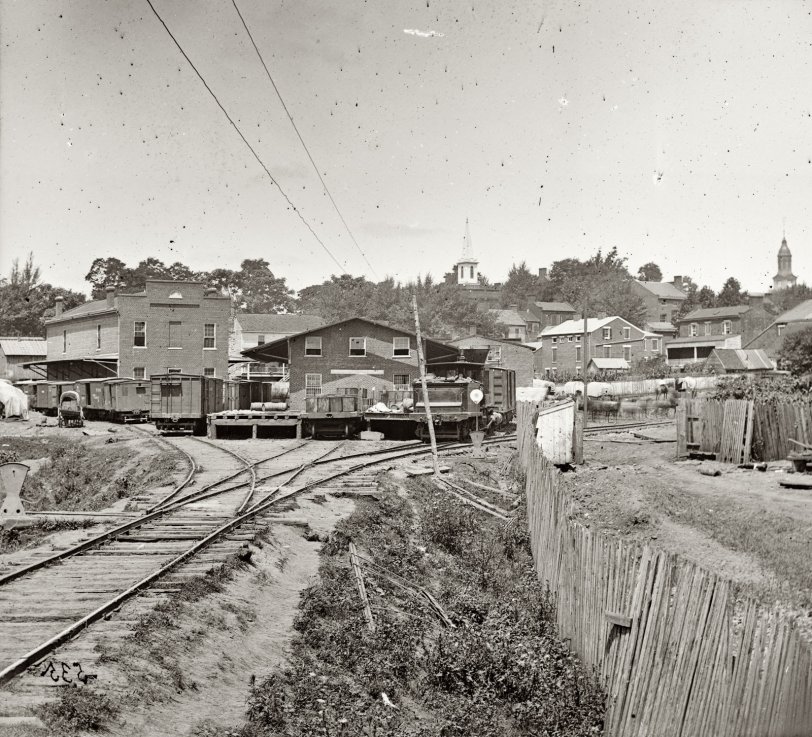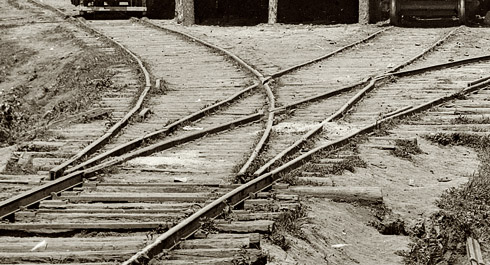


Framed or unframed, desk size to sofa size, printed by us in Arizona and Alabama since 2007. Explore now.
Shorpy is funded by you. Patreon contributors get an ad-free experience.
Learn more.

- Baldwin 62303
- Baldwin VO-1000
- Cold
- No expense spared
- Tough Guys
- Lost in Toyland
- And without gloves
- If I were a blindfolded time traveler
- Smoke Consumer Also Cooks
- Oh that stove!
- Possibly still there?
- What?!?
- $100 Reward
- Freeze Frame
- Texas Flyer wanted
- Just a Year Too Soon
- WWII -- Replacing men with women at the railroad crossing.
- Yes, Icing
- You kids drive me nuts!
- NOT An Easy Job
- I wonder
- Just add window boxes
- Icing Platform?
- Indiana Harbor Belt abides
- Freezing haze
- Corrections (for those who care)
- C&NW at Nelson
- Fallen Flags
- A dangerous job made worse
- Water Stop
Print Emporium
Culpeper: 1862

August 1862. "Culpeper Court House, Virginia. Railroad depot." Photographs from the main Eastern theater of war, Bull Run, second Battle of Bull Run. Wet plate negative, half of stereo pair, by Timothy O'Sullivan. View full size.
Brickwork pattern
I can think of no explanation for the light-dark pattern on the brickwork facing us in the center. The lower inverted V suggests an older structure since removed. But that theory is nixed by the identical coloration in the isolated band above. I'm stumped.
[It's a shadow cast by the eave. Which is missing a board on the right. - Dave]
U Rail
Note the ends of hollow "U Rail" showing. One of the predecessors of the modern "T Rail," and a big improvement over strap rail-- strips of iron nailed to wood rails that frequently tore loose and came up through the wooden car floors ("a snakehead").
Image Quality
Wet-plate collodion photography, especially glass plate negatives, are considered to provide the clearest images providing in some cases far more detail than digital. The out of focus effect is you observe at the edge of the image is called "bokeh" and caused by the fall off of the petzval-type lens.
A wet-plate artist would have to make his own "film" for each image. Pouring collodion on a glass plate and sensitizing it in a sliver nitrate bath before exposing in in the camera. Then he would bring it back to his dark tent and develop and fix it. All of this had to be done within 10 to 30 minutes before the plate dried.
Three-Way Stub Switch
Phillip is correct about that stub switch. Rail fans go crazy over these. This one is even rarer, as it is a three-way stub switch. (Drool, drool.)
Trackwork
I find the track work in this photo very interesting.
Seems to be very rough in comparison with modern workmanship. No wonder when reading of railroads during the War Between the States, the schedules were very slow and iffy. The switches are interesting too. Stub type with a rather novel switch stand.
Quality, Film Plane, Age.
You can tell the film wasn't completely on-plane if you look at the out of focus steeple next to the in-focus steeple.
That is a fantastically high-quality photograph for 1862.
I'd almost question this photograph was from 1862 if it weren't for the telegraph pole and accompanying insulators that match for that period.
["Film" did not exist in 1862. - Dave]

























On Shorpy:
Today’s Top 5